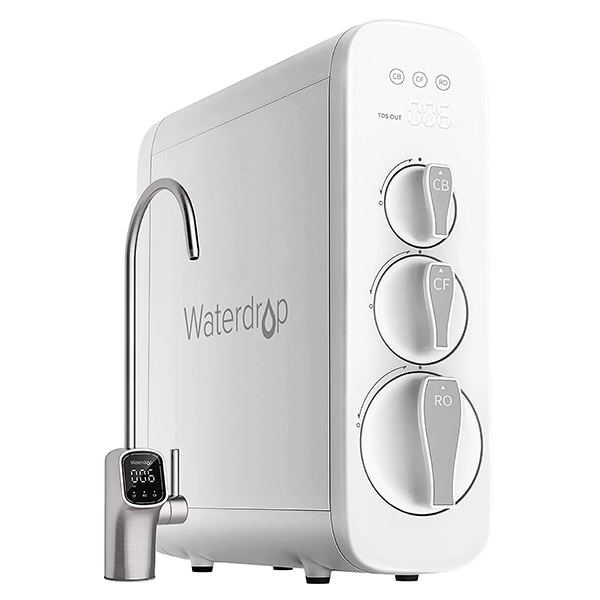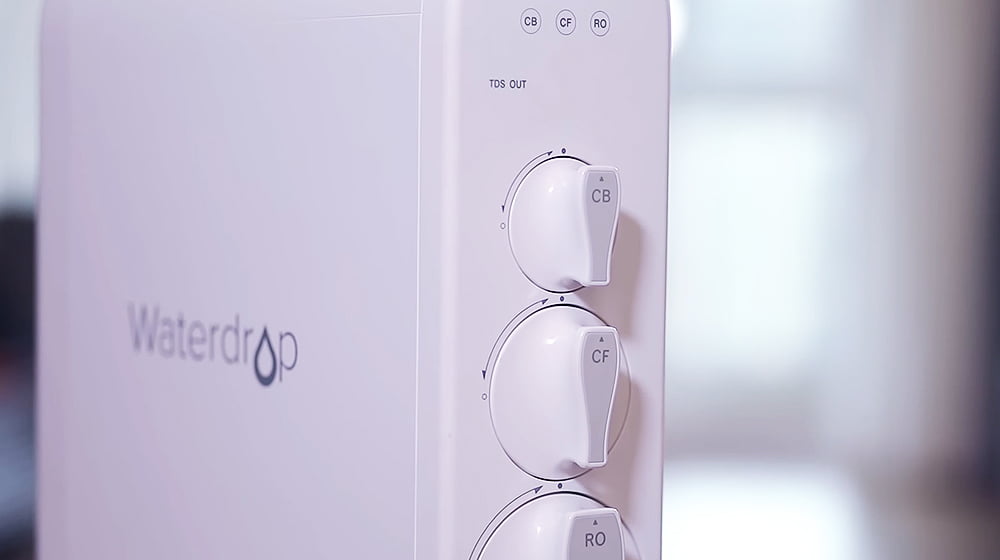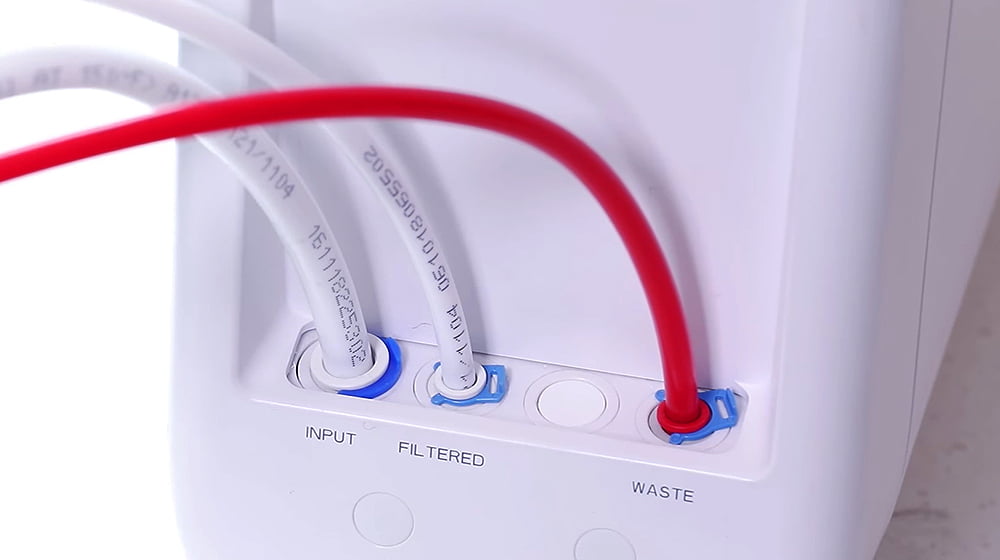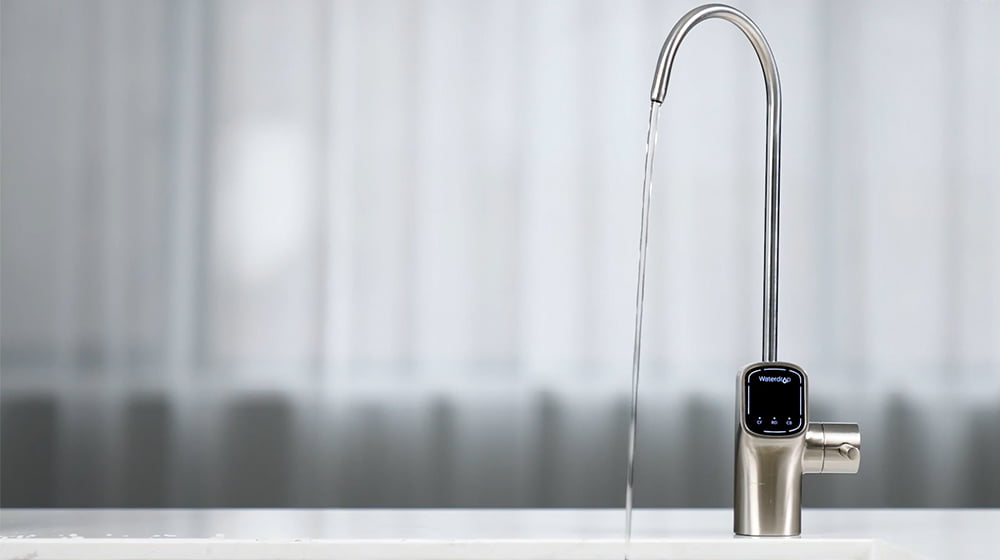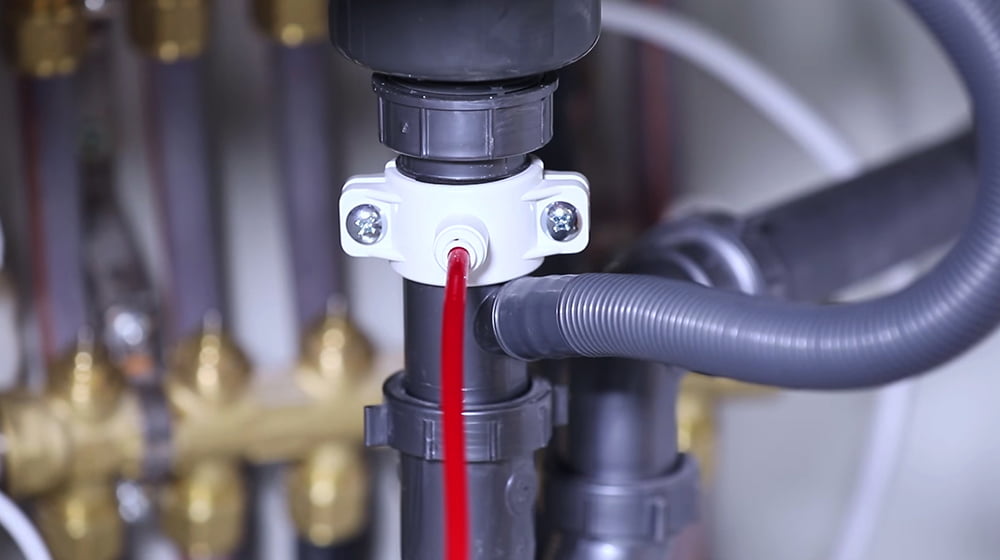Review: Waterdrop G3P800 Reverse Osmosis System
Written by: Gene Fitzgerald // Expert Fact-Checking: Buddhini Dolapihilla, MBSS // Last Updated: Dec 18, 2023
This page may contain affiliate links. If you buy a product or service through such a link we earn a commission at no extra cost to you. Learn more.
The Waterdrop G3P800 Reverse Osmosis System goes under the sink and uses a tankless, space-saving design. Filtration is fast, and wastewater is minimal. What else should you know about this system? Stay on this review to find out.
Waterdrop G3P800 Reverse Osmosis System – All Specs
- Model: G3P800
- Last Price: $999.00
- Annual Maintenance Cost: ~$230
- Filter Media/Process: Sediment, 2x Carbon Block, RO Membrane, UV
- Filter Stages: 5
- Flow Rate: 0.56 gpm
- Membrane Rating: 800 gpd
- Recovery Rate: 75%
- Filtering Capacity: 800-3,200 gal
- WxHxD: 5.67″x17.72″x18.12″
- Water Temperature: 41-100 °F
- Water Pressure: 14.5-87 psi
- Fittings: 3/8”-1/2″
- NSF Testing: Standards 42, 53, 401
- NSF Certifications: Standards 58, 372
- Warranty: 1 Year
Waterdrop G3P800 Discount Code
You can use our code “WD10BOS“ to get 10% off when you purchase the Waterdrop G3P800 on waterdropfilter.com.
Waterdrop G3P800 – Key Features
Most importantly, the Waterdrop G3P800 Reverse Osmosis System has a tankless design that saves space under the sink. Tankless means the system needs to filter water on demand, and because reverse osmosis water purification is very slow, an electric pump is required to get a speed boost. This enables the Waterdrop G3P800 to achieve a flow rate of around 0.56 gallons per minute – pretty fast. You can fill a cup in seconds.
The Waterdrop works with a 5-stage filter process. Below are the stages and how they work:
- Composite filter (CF): The composite filter has two layers of polypropylene cotton and one layer of coconut shell activated carbon block.
- Reverse osmosis membrane: The RO membrane has a pore size of 0.0001 microns that rejects contaminants above that size. It eliminates everything you’d expect from a typical RO membrane.
- Carbon block filter (CB): The fourth stage is an activated carbon post-filter block that removes any lingering contaminants in the water. Its role is to give the water a finishing touch and improve its aesthetics.
- UV: This stage has a long-lasting LED lamp that lights up as water flows. The UV light kills microorganisms and has a sterilization rate of 99.9%, says Waterdrop.
All in all, the Waterdrop G3P800 is NSF-tested and partially certified (more on this below) to remove the following water impurities: TDS, heavy metals like arsenic, lead, and chromium 6, salts like fluoride, bad taste and odor, sediment, and all kinds of organic chemicals like PFAS and VOCs. This means after filtration, your water will be much healthier to drink and also better-tasting.
One more key feature to point out is the system’s smart faucet which shows output water TDS and filter status – reminds you when to replace filters. The same can be found on the system front panel.
Lifespan of filter components:
- Pre sediment and carbon block filter: 6 months or 800 gallons
- RO membrane: 24 months or 3,200 gallons
- The carbon post-filter: 12 months or 1,600 gallons
Annual maintenance costs are around $230 which is more on the higher side but still acceptable.
Alexa’s Video Review
Being part of the BOS team, Alexa has ordered and tested the Waterdrop G3 Reverse Osmosis System, which means she has installed the system with her own hands and used it for several weeks for some genuine first-hand experience! Alexa has documented the entire process, including her findings and personal verdict, in the video provided below. Just note that this is a review of the original Waterdrop G3 (which is almost identical to the G3P800 except for the lower flow rate and the missing UV light stage):
Waterdrop G3P800 RO System Pros
The Waterdrop G3P800 Reverse Osmosis System has its perks. It’s an 800 gpd (gallon per day) unit that provides water fast. And due to the pressure pump, wastewater ratio is down to 3:1, which is really good! Essentially, only 1 gallon goes down the drain per 3 gallons purified. In contrast, a standard under sink RO system without pump wastes 3-5 gallons of water per 1 gallon purified.
What’s more, filter replacements are tools-free and only take seconds. Another upside is that the system is ready for DIY installation, so you don’t need to involve a plumber.
Finally, the product is backed by a 1-year limited warranty as well as a 30-day money-back guarantee, and it is BPA-free.
What Contaminants Are Being Removed?
The Waterdrop G3P800 has been tested/certified against NSF standards 42, 53, and 401 to remove:
- 99% chlorine
- 98% TDS
- 98% nitrate
- 99% fluoride
- 99% arsenic
- 99% lead
- 99% mercury
- 99% PFOS/PFOA
- 99% chromium 6
- 99.999% total coliforms
- Dozens of VOCs (up to 99%)
It is highly effective!
The Waterdrop G3P800 – learn more on Waterdropfilter.com
Installation
The system comes ready for DIY installation, so you don’t need to involve a professional plumber – saves money!
Tools needed for installation are:
- Screwdriver
- Towel
- Variable speed drill
- Drill bit: 1″ (for faucet hole), ¼” (for drainpipe)
- Adjustable wrench, pliers
- Flashlight
- Utility knife or scissors
Here’s how to install:
- Turn off the water supply and open the kitchen faucet to release water pressure.
- Disconnect the cold water pipe from its supply valve and latch the feed water adapter onto the cold water supply valve (tighten with your adjustable wrench).
- Next, twist the cold water pipe onto the feed water adapter and secure it with an adjustable wrench.
- Fit the faucet spout into the faucet body and slip the faucet stem and power cord into a suitable countertop/sink hole.
- Below the sink, place the mounting washer on the faucet stem, slide on the nut, and tighten it. Then, insert the end of the UV sterilizer into the faucet stem and lock it in.
- Next, install the drain saddle. Fix the foam seal onto the front plate of the drain saddle, and make sure the hole in the foam seal and the hole in the front panel align. Select a convenient location on the drain pipe for installing the drain saddle.
- Drill a ¼” hole into the drainpipe (don’t penetrate the other side of the pipe), then insert the tubing into the drilled hole for about 0.6″. Tighten all screws and nuts with the tubing still in the hole, then pop the lock clip on the fitting to secure the connection.
- Position the RO system. It’s best to avoid placing the housing against the cabinet because there may be vibrations as the system works.
- Connect the input water tubing, filtered water tubing, and wastewater tubing.
- Connect the RO faucet and UV sterilizer to the system and insert the power cords. Then, connect the power adapter.
- Remove the filters from their protective wrappings and install them. Each filter is marked with a logo and an installation arrow.
- Start up the system. Note: You should let the RO faucet run for 30 minutes until the front panel shows a TDS reading.
- Turn off the system and check for leaks.
The Package (Parts)
- System housing
- WD-G3-CB filter
- WD-G3-CF filter
- WD-G3P800-RO membrane
- Smart faucet
- Tubing
- UV sterilizer
- Feed water adapter
- Lock clips
- Teflon tape
- Drain saddle
- Power adapter
Maintenance
Filters are easy to replace (it only takes a few seconds). There’s no need to shut off the water, and there are no tools involved. Annual maintenance cost is around $230, higher than many other RO systems but still acceptable. The Smart faucet has a filter life indicator that tells you when to replace old filters. Here’s what the indicator lights mean:
- White: The filters are working fine.
- Yellow: The remaining filter capacity is less than 15 days or 40 gallons.
- Red: You need to change one or more filters immediately.
The pre-sediment + carbon block lasts 6 months or 800 gallons. The RO membrane lasts 24 months or 3,200 gallons. While the carbon filter (CB) has a lifespan of 1,600 gallons or 12 months.
Follow these steps to replace old filters:
- Turn off the faucet and wait 30 seconds to release the internal pressure in the RO system.
- Twist the exhausted filter in the counterclockwise direction.
- Twist the new filter into the housing in a clockwise motion.
- Reset the filter life indicator (you must flush the filter after replacement).
Manual
Here is a link to the official manual:
NSF and Other Certifications
The Waterdrop G3P800 has undergone testing for NSF standards 42, 53, and 401. It also holds NSF certifications against Standards 58 for the reduction of cadmium, selenium, TDS, fluoride, and hexavalent chromium, as well as Standard 372 for material safety and structural integrity.
Earlier Product Versions
Earlier product versions of the G3P800 include the G3 and the G3P600. The filtration process with these older versions is pretty much the same, but the G3 is a 400 gpd system while the G3P600 is a 600 gpd system. Compared to the G3P800, these earlier versions are slower and don’t provide as much filtered water as the G3P800. Another difference is that the G3P800 has a UV sterilization stage.
Recovery rate is also better with the G3P800. Here’s the pure-to-drain water ratio of the three product versions:
- G3P800: 3:1
- G3P600: 2:1
- G3: 1:1
Cons
Pricing is pretty expensive at $999 (but you could get it at a discount). And although the G3P800 has 2 NSF certifications, we would have liked a few more.
Another issue we have is that you’ll have to drain up to a gallon of water before reaching optimum TDS levels, depending on how long the system has been sitting unused. To be fair, though, this phenomenon is known as TDS creep and is pretty normal with RO systems.
The system has a user-friendly design, but some users complained about it producing annoying noises even while it isn’t dispensing water. There were also complaints about the filter leaking, and some people were unsatisfied with the overall filtration.
Waterdrop G3P800 Review: Our Verdict + Best for
The Waterdrop G3P800 tankless under sink reverse osmosis system is undoubtedly one of the higher-end RO systems. But it’s also the highest-priced model we know. High price aside, people are happy with the sleek design and satisfied with the easy install and fast filter replacements. There were a lot of positive comments about the filtered water tasting great, too.
The system has NSF testing and certifications that give it credibility. It’s perfect for people who want a fast, effective, compact, and tankless RO system. We rate it a solid 4 stars.
Our Rating in Detail:
- Filtration Performance: 4.5/5.0
- Filter Capacity (Life): 4.5/5.0
- Purchase Price: 3.0/5.0
- Annual Cost: 4.0/5.0
- Overall: 4.0/5.0
Get 10% Off! Use Code: WD10BOS
Comparison to Other Reverse Osmosis Systems
Let’s compare the G3P800 to two countertop RO systems, the AquaTru and SimPure Y7P. They’re both installation-free systems. We’re comparing the G3P800 to these countertop systems because, right now, we don’t really have an under sink RO system that can be compared to the Waterdrop G3P800.
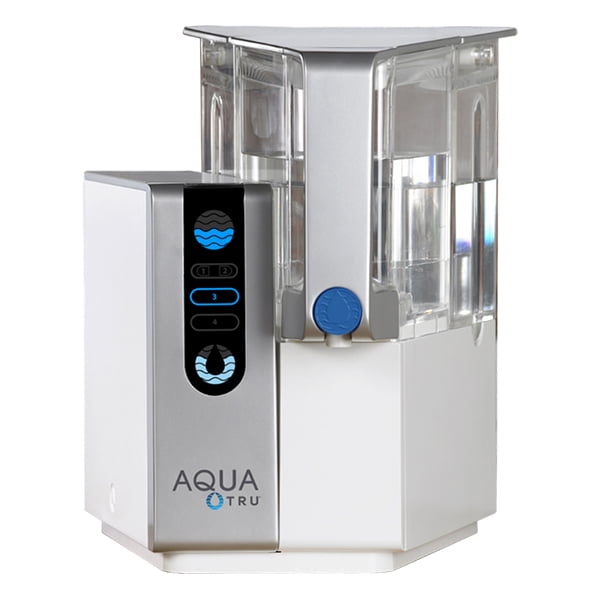
AquaTru |
|
| Price: | $$$ |
| Filter Stages: | 4 |
| Flow Rate: | 1 Gallon in 10-15 Minutes |
| NSF Certifications: | 42, 53, 58, 401, P473 |
| Annually: | ~$100-120 |
|
Overall Rating: 4.5/5.0 ⓘRating based on filtration performance, filter life, price and yearly cost, NSF testing/certification, customer support, product warranty, our testing/experience, user feedback, and other factors.
Get 15% Off! Use Code: |
|

SimPure Y7P-BW |
|
| Price: | $$ |
| Filter Stages: | 4 |
| Flow Rate: | 0.1 Gallons Per Minute |
| NSF Certifications: | 58 |
| Annually: | $120 |
|
Overall Rating: 4.5/5.0 ⓘRating based on filtration performance, filter life, price and yearly cost, NSF testing/certification, customer support, product warranty, our testing/experience, user feedback, and other factors.
Get 20% Off! Use Code: |
|
Let’s talk about the AquaTru system. First, it costs way less than the Waterdrop G3P800 (less than half!).
It’s by far our favorite reverse osmosis system, and it’s not just because of its low cost. The AquaTru uses a 4-stage filtration process that’s been independently tested and certified against NSF standards to remove almost 80 contaminants.
It holds 5 NSF/ANSI certifications for contaminant reduction (Standards 42, 53, 58, 401, and P473). This is a solid lineup and pretty impressive. These certifications endorse the system and guarantee its effectiveness. Here’re some of the AqauTru’s reduction rates:
- Chlorine, 96.6%
- VOCs, 95% to more than 99%
- PFOA & PFOS, 97.5%
- Lead, 99.1%
- Chromium 6, 97.2%
- TDS, 87.1%
- Fluoride, 93.5%
- BPA, 99%
- Cyst, 99.99%
- Radium 226/228, 96.4%
- Several trace pharmaceuticals and pesticides, 86.7%-96.6%
The Waterdrop seems to have higher reduction rates, but the AquaTru is tested for more contaminants.
The AquaTru is also extremely easy to set up (takes 10 minutes tops) and has a simple, space-saving design that doesn’t get in the way. It’s perfect if you’re renting and can’t make changes to your plumbing or drill in your countertop for an RO faucet.
It filters water quickly, so there are no long wait times. With an 80% recovery rate (only ⅕ of the feed water goes down the drain), the AquaTru produces very little wastewater, beating the Waterdrop here.
An added plus is filter elements last long and are easy to replace (2 minutes max, completely toolless). You spend minimal effort on maintenance. The AquaTru also has an indicator light that lets you know when your filters are due for replacement. They have a 6-24 months lifespan, costing up to $120 in annual replacements (the Waterdrop costs twice as much to maintain).
Finally, the AquaTru uses BPA and BPS-free Tritan plastic only. And there’s a limited 1-year warranty.
Despite its good points, past users have complained about leaks caused by design flaws. We’ve also seen reports of the unit breaking down after a few months.
Next on our comparison list is the SimPure system. We’d say it’s a close second to the AquaTru (it’s also more affordable than the AquaTru and costs ⅓ of the Waterdrop).
The SimPure is installation-free, so it’s very easy to set up. It filters water using a 4-stage filter process which includes a UV post-filter that kills dangerous microorganisms. The Waterdrop G3P800 uses a UV stage, too, but the AquaTru doesn’t have this.
The SimPure has been tested against NSF 58 but doesn’t hold any official NSF certifications. It also hasn’t been tested for that many contaminants (16 in total), including:
- Chlorine, >99.45%
- PFOA, >98.75%
- PFOS, >98.30%
- Chromium-6, >99.28%
- Lead, >98.46%
- Arsenic, 99.65%
- Nitrate, 96.26%
- TDS, 98.64%
- Turbidity, 99.47%
- Total coliforms, 99.99%
The SimPure wastes 1 gallon for every 4 filtered gallons (the same wastewater ratio as the AquaTru, but better than the Waterdrop). It’s also pretty fast, so you won’t wait hours for a glass. There’s also an interesting cup size selection feature: you can select 6 oz, 12 oz, 15 oz, or continuous flow.
The SimPure is made from BPA-free material. Its filters are easy to change, and the filter life indicator ensures you don’t miss replacement dates. Filters last for 6 months or 528 gallons, and annual replacements cost $120 (cheaper than the Waterdrop and around the same as the AquaTru). It has a 1-year warranty.
Bottom line: If you’re set on getting an under sink RO system, go with the Waterdrop. But remember, it’s pricey, so you must have the cash. But if you are okay with getting a countertop, we recommend the AquaTru. The SimPure is also great if you’re working on a smaller budget.
This completes our review of the Waterdrop G3P800 Reverse Osmosis System. If you have any questions please don’t hesitate to leave a comment below!
Information provided on BOS is for educational purposes only. The products and services we review may not be right for your individual circumstances.
We adhere to strict editorial guidelines. Rest assured, the opinions expressed have not been provided, reviewed, or otherwise endorsed by our partners – they are unbiased, independent, and the author’s alone. Our licensed experts fact-check all content for accuracy. It is accurate as of the date posted and to the best of our knowledge.

